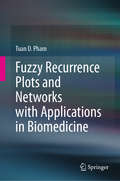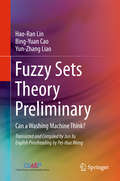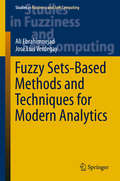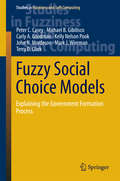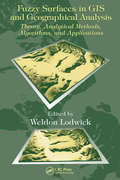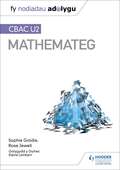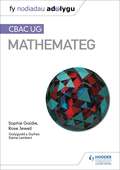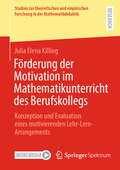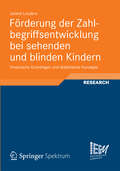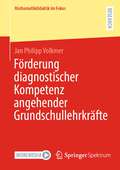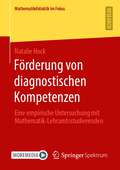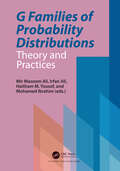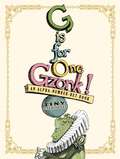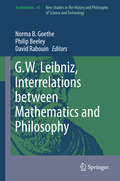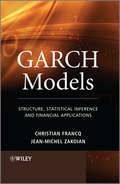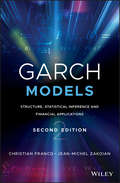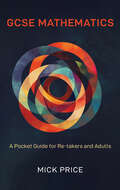- Table View
- List View
Fuzzy Recurrence Plots and Networks with Applications in Biomedicine
by Tuan D. PhamThis book presents an original combination of three well-known methodological approaches for nonlinear data analysis: recurrence, networks, and fuzzy logic.After basic concepts of these three approaches are introduced, this book presents recently developed methods known as fuzzy recurrence plots and fuzzy recurrence networks. Computer programs written in MATLAB, which implement the basic algorithms, are included to facilitate the understanding of the developed ideas. Several applications of these techniques to biomedical problems, ranging from cancer and neurodegenerative disease to depression, are illustrated to show the potential of fuzzy recurrence methods. This book opens a new door to theorists in complex systems science as well as specialists in medicine, biology, engineering, physics, computer science, geosciences, and social economics to address issues in experimental nonlinear signal and data processing.
Fuzzy Sets Theory Preliminary: Can A Washing Machine Think?
by Bing-Yuan Cao Hao-Ran Lin Yun-Zhang LiaoThis basic book has been used at the middle schools in Shanghai, China for more than 10 years. The book presents carefully-selected contents in order to achieve the roles of enlightenment and popularization. It mainly includes: Chapter 1: Human Brains, Computers and Fuzzy Mathematics; Chapter 2: Matrix, Fuzzy Relations and Fuzzy Matrix; Chapter 3: Fuzzy Control; Chapter 4: Fuzzy Statistics and Fuzzy Probability and Chapter 5: Fuzzy Linear Programming. It includes at the end of each chapter concise, interesting and profound reading and thinking materials, and a certain amount of exercises so as to make it an informative and interesting textbook. This book can be used not only as a textbook in senior middle schools, and in vocational colleges, but also as a primer for individually learning fuzzy mathematics.
Fuzzy Sets, Rough Sets, Multisets and Clustering
by Vicenç Torra Yasuo Narukawa Anders DahlbomThis book is dedicated to Prof. Sadaaki Miyamoto and presents cutting-edge papers in some of the areas in which he contributed. Bringing together contributions by leading researchers in the field, it concretely addresses clustering, multisets, rough sets and fuzzy sets, as well as their applications in areas such as decision-making. The book is divided in four parts, the first of which focuses on clustering and classification. The second part puts the spotlight on multisets, bags, fuzzy bags and other fuzzy extensions, while the third deals with rough sets. Rounding out the coverage, the last part explores fuzzy sets and decision-making.
Fuzzy Sets-Based Methods and Techniques for Modern Analytics (Studies in Fuzziness and Soft Computing #364)
by José Luis Verdegay Ali EbrahimnejadThe book offers a comprehensive, practice-oriented introduction to the field of fuzzy mathematical programming (FMP) as key topic of modern analytics. FMP plays a fundamental role in dealing with a varied range of problems, such as those concerning smart cities, sustainability, and renewable energies. This book includes an introduction to the basic concepts, together with extensive information on the computational-intelligence-based optimization models and techniques that have been used to date. Special emphasis is given to fuzzy transportation problems. The book is a valuable resource for researchers, data scientists and practitioners dealing with computational-intelligence-based optimization models for analytics.
Fuzzy Social Choice Models
by Peter C. Casey Michael B. Gibilisco Carly A. Goodman Kelly Nelson Pook John N. Mordeson Mark J. Wierman Terry D. ClarkThis book explores the extent to which fuzzy set logic can overcome some of the shortcomings of public choice theory, particularly its inability to provide adequate predictive power in empirical studies. Especially in the case of social preferences, public choice theory has failed to produce the set of alternatives from which collective choices are made. The book presents empirical findings achieved by the authors in their efforts to predict the outcome of government formation processes in European parliamentary and semi-presidential systems Using data from the Comparative Manifesto Project (CMP), the authors propose a new approach that reinterprets error in the coding of CMP data as ambiguity in the actual political positions of parties on the policy dimensions being coded. The range of this error establishes parties' fuzzy preferences. The set of possible outcomes in the process of government formation is then calculated on the basis of both the fuzzy Pareto set and the fuzzy maximal set, and the predictions are compared with those made by two conventional approaches as well as with the government that was actually formed. The comparison shows that, in most cases, the fuzzy approaches outperform their conventional counterparts.
Fuzzy Solution Concepts for Non-cooperative Games: Interval, Fuzzy and Intuitionistic Fuzzy Payoffs (Studies in Fuzziness and Soft Computing #383)
by Amit Kumar Tina VermaThis book proposes novel methods for solving different types of non-cooperative games with interval/fuzzy/intuitionistic fuzzy payoffs. It starts by discussing several existing methods and shows that some mathematically incorrect assumptions have been considered in all these methods. It then proposes solutions to adapt those methods and validate the new proposed methods, such as Gaurika method Ambika-I-IV, Mehar method and others, by using them for solving existing numerical problems. The book offers a comprehensive guide on non-cooperative games with fuzzy payoffs to both students and researchers. It provides them with the all the necessary tools to understand the methods and the theory behind them.
Fuzzy Statistical Inferences Based on Fuzzy Random Variables
by Gholamreza HesamianThis book presents the most commonly used techniques for the most statistical inferences based on fuzzy data. It brings together many of the main ideas used statistical inferences in one place based on fuzzy information including fuzzy data. This book covers a much wider range of topics than a typical introductory text on fuzzy statistics. It includes common topics like elementary probability, descriptive statistics, hypothesis tests, one-way ANOVA, control-charts, reliability systems and regression models The reader is assumed to know calculus and a little fuzzy set theory. The conventional knowledge of probability and statistics is required. Key Features: Includes example in Mathematica and MATLAB. Contains theoretical and applied exercises for each section. Presents various popular methods for analyzing fuzzy data. The book is suitable for students and researchers in statistics, social science, engineering, and economics, and it be used at graduate and P.h.D level.
Fuzzy Stochastic Optimization
by Shuming Wang Junzo WatadaCovering in detail both theoretical and practical perspectives, this book is a self-contained and systematic depiction of current fuzzy stochastic optimization that deploys the fuzzy random variable as a core mathematical tool to model the integrated fuzzy random uncertainty. It proceeds in an orderly fashion from the requisite theoretical aspects of the fuzzy random variable to fuzzy stochastic optimization models and their real-life case studies. The volume reflects the fact that randomness and fuzziness (or vagueness) are two major sources of uncertainty in the real world, with significant implications in a number of settings. In industrial engineering, management and economics, the chances are high that decision makers will be confronted with information that is simultaneously probabilistically uncertain and fuzzily imprecise, and optimization in the form of a decision must be made in an environment that is doubly uncertain, characterized by a co-occurrence of randomness and fuzziness. This book begins by outlining the history and development of the fuzzy random variable before detailing numerous optimization models and applications that include the design of system controls for a dam.
Fuzzy Surfaces in GIS and Geographical Analysis: Theory, Analytical Methods, Algorithms and Applications
by Weldon LodwickSurfaces are a central to geographical analysis. Their generation and manipulation are a key component of geographical information systems (GISs). However, geographical surface data is often not precise. When surfaces are used to model geographical entities, the data inherently contains uncertainty in terms of both position and attribute. Fuzzy
Fuzzy XML Data Management
by Li Yan Zongmin Ma Fu ZhangThis book presents an exhaustive and timely review of key research work on fuzzy XML data management, and provides readers with a comprehensive resource on the state-of-the art tools and theories in this fast growing area. Topics covered in the book include: representation of fuzzy XML, query of fuzzy XML, fuzzy database models, extraction of fuzzy XML from fuzzy database models, reengineering of fuzzy XML into fuzzy database models, and reasoning of fuzzy XML. The book is intended as a reference guide for researchers, practitioners and graduate students working and/or studying in the field of Web Intelligence, as well as for data and knowledge engineering professionals seeking new approaches to replace traditional methods, which may be unnecessarily complex or even unproductive.
Fy Nodiadau Adolygu: CBAC U2 Mathemateg (My Revision Notes)
by Sophie Goldie Rose JewellTarget success in the new specification WJEC A2 Mathematics with this proven formula foreffective, structured revision; key content coverage is combined with full worked examples, diagnostic questions and exam-style questions to create a revision guide that students can rely on to review, strengthen and test their knowledge. Help develop the key skills needed for success with skills-focused questions around problem-solving,proof, modelling and the use of ICT (spreadsheets, graphing software and graphing calculators). Strategically target revision with diagnostic questions to establish which areas need focus. Get assessment-ready with exam-style questions and advice on common examination pitfalls. Develop students' understanding with full worked examples and accompanying solutions, offeringdetailed, instructive explanations. Consolidate revision with summaries for each topic that focus on what to concentrate on in the buildupto exams, with special focus on common pitfalls such as how to show correct workings. Enable independent learning with access to answers in the back of the book.
Fy Nodiadau Adolygu: CBAC U2 Mathemateg (My Revision Notes: WJEC A2 Mathematics Welsh-language edition)
by Sophie Goldie Rose JewellTarget success in the new specification WJEC A2 Mathematics with this proven formula foreffective, structured revision; key content coverage is combined with full worked examples, diagnostic questions and exam-style questions to create a revision guide that students can rely on to review, strengthen and test their knowledge. Help develop the key skills needed for success with skills-focused questions around problem-solving,proof, modelling and the use of ICT (spreadsheets, graphing software and graphing calculators). Strategically target revision with diagnostic questions to establish which areas need focus. Get assessment-ready with exam-style questions and advice on common examination pitfalls. Develop students' understanding with full worked examples and accompanying solutions, offeringdetailed, instructive explanations. Consolidate revision with summaries for each topic that focus on what to concentrate on in the buildupto exams, with special focus on common pitfalls such as how to show correct workings. Enable independent learning with access to answers in the back of the book.
Fy Nodiadau Adolygu: CBAC UG Mathemateg (My Revision Notes)
by Sophie Goldie Rose JewellTarget success in the new specification WJEC GCE AS Mathematics with this proven formula for effective, structured revision; key content coverage is combined with full worked examples, diagnostic questions and exam-style questions to create a revision guide that students can rely on to review, strengthen and test their knowledge. Help develop the key skills needed for success with skills-focused questions around problem-solving, proof, modelling and the use of ICT (spreadsheets, graphing software and graphing calculators). Strategically target revision with diagnostic questions to establish which areas need focus. Get assessment-ready with exam-style questions and advice on common examination pitfalls. Develop students' understanding with full worked examples and accompanying solutions, offering detailed, instructive explanations. Consolidate revision with summaries for each topic that focus on what to concentrate on in the buildup to exams, with special focus on common pitfalls such as how to show correct workings. Enable independent learning with access to answers in the back of the book.
Fy Nodiadau Adolygu: CBAC UG Mathemateg (My Revision Notes: WJEC AS Mathematics Welsh-language edition)
by Sophie Goldie Rose JewellTarget success in the new specification WJEC GCE AS Mathematics with this proven formula for effective, structured revision; key content coverage is combined with full worked examples, diagnostic questions and exam-style questions to create a revision guide that students can rely on to review, strengthen and test their knowledge. Help develop the key skills needed for success with skills-focused questions around problem-solving, proof, modelling and the use of ICT (spreadsheets, graphing software and graphing calculators). Strategically target revision with diagnostic questions to establish which areas need focus. Get assessment-ready with exam-style questions and advice on common examination pitfalls. Develop students' understanding with full worked examples and accompanying solutions, offering detailed, instructive explanations. Consolidate revision with summaries for each topic that focus on what to concentrate on in the buildup to exams, with special focus on common pitfalls such as how to show correct workings. Enable independent learning with access to answers in the back of the book.
Förderung der Entwicklung im mittleren und höheren Lebensalter: Eine Perspektive der positiven Psychologie
by Irina Catrinel CrăciunDieses Handbuch integriert und erörtert eine wachsende Evidenzbasis zur individuellen Entwicklung im mittleren und späten Erwachsenenalter. Das Buch enthält eine umfassende Analyse dessen, was Wachstum in der Lebensmitte und im höheren Alter bedeutet, und zeigt auf, wie verschiedene Entwicklungsbereiche miteinander verwoben sind (d. h. körperliche, kognitive, soziale und emotionale Entwicklung sowie Persönlichkeitsentwicklung). Da die Kluft zwischen Theorie und Praxis immer noch ein Problem in der Entwicklungsforschung darstellt, zielt das Handbuch auch darauf ab, anschauliche Beispiele für Prävention und Intervention aus der Perspektive der positiven Psychologie zu liefern. Diese wurden so ausgewählt, dass sie eine Vielzahl von Themen repräsentieren, die für die individuelle Entwicklung relevant sind und bei denen die Forschung die Praxis beeinflusst, von Glück, Großelternschaft, Liebe und Sexualität bis hin zu Einsamkeit, Depression, Angst, Suizidprävention und Bewältigung des Todes.Dieses Handbuch ist ein unverzichtbares Hilfsmittel für Studenten und Forscher, die in den Bereichen Entwicklungspsychologie, Gesundheitspsychologie, Gerontologie und öffentliche Gesundheit arbeiten. Es ist auch für Praktiker wie Berater, Life Coaches, Psychotherapeuten, Organisationspsychologen, Gesundheitsfachleute, Sozialarbeiter und Planer im Bereich der öffentlichen Gesundheit von Interesse.
Förderung der Motivation im Mathematikunterricht des Berufskollegs: Konzeption und Evaluation eines motivierenden Lehr-Lern-Arrangements (Studien zur theoretischen und empirischen Forschung in der Mathematikdidaktik)
by Julia Elena KillingDie vorliegende Arbeit stellt die Konzeption und Evaluation von zwei Lehr-Lern-Arrangements zum Themengebiet der Stochastik am Berufskolleg dar. Die Evaluation der beiden Lehr-Lern-Arrangements erfolgt durch die Auswertung der Wirkung auf die Motivation der Lernenden in einer quantitativ quasi-experimentellen Interventionsstudie im Prä-Post-Design. Zur Auswertung wurde die Motivation vor und nach den Lehr-Lern-Arrangements sowie die Leistungsfähigkeit zu Beginn des Lehr-Lern-Arrangements der N = 195 teilnehmenden Lernenden aus fünf Berufskollegs erhoben und kumulativ ausgewertet. Die Auswertung zeigt, dass sich die Motivation der Lernenden lediglich im betrieblichen Lehr-Lern-Arrangement signifikant verbessern ließ. Im anwendenden Lehr-Lern-Arrangement und in der Kontrollgruppe ließen sich keine signifikanten Veränderungen der Motivation feststellen. Ebenfalls ließ sich kein Zusammenhang zwischen der Wirkung der Lehr-Lern-Arrangements auf die Motivation und der vorherigen Leistungsfähigkeit der Lernenden feststellen. Daher lässt sich insgesamt schlussfolgern, dass betriebliche Lehr-Lern-Arrangements einen positiven Einfluss auf die Motivation von Lernenden am Berufskolleg haben.
Förderung der Zahlbegriffsentwicklung bei sehenden und blinden Kindern
by Juliane LeudersDie wissenschaftliche Kenntnislage zur Entwicklung mathematischer Kompetenzen bei blinden Kindern ist lückenhaft, heterogen und teilweise widersprüchlich. Auch für sehende Kinder wurden psychologische Forschungsergebnisse bisher nur teilweise aus didaktischer Perspektive ausgewertet. Juliane Leuders bietet einen umfassenden Überblick über den deutschen und englischsprachigen Forschungsstand zu den Grundlagen des Arithmetiklernens von sehenden und blinden Vorschulkindern und Schulanfängern. Sie thematisiert neuro- und wahrnehmungspsychologische Grundlagen des Hörens und Tastens und erörtert kognitive Prozesse und die Entwicklung des zahlbezogenen Denkens. Im didaktischen Teil beschreibt sie den Kompetenzerwerb im inklusiven Unterricht, die Qualität von Veranschaulichungen und erarbeitet konkrete Vorschläge für die Adaption von Unterrichtsmaterialien.
Förderung diagnostischer Kompetenz angehender Grundschullehrkräfte (Mathematikdidaktik im Fokus)
by Jan Philipp VolkmerDiagnostische Kompetenz ist eine der zentralen Kompetenzen von Lehrkräften. Diese Kompetenz hängt von der jeweiligen diagnostischen Situation ab. Das Analysieren von reichhaltigen Schüler*innendokumenten, wie sie zum Beispiel bei der Bearbeitung offener Lernangebote entstehen, wurde als diagnostische Situation bisher kaum betrachtet. Das vorliegende Buch widmet sich daher der Operationalisierung und Förderung diagnostischer Kompetenz bezüglich der Analyse von Schüler*innendokumenten zu offenen Lernangeboten der Arithmetik. Dazu wird eine Operationalisierung der diagnostischen Kompetenz und insbesondere des diagnostichen Denkens als Synthese bisheriger Forschung vorgeschlagen. Die Operationalisierung stützt sich auf die Adaption epistemischer Aktivitäten und einen adaptierten Prozess des Anpassens und Vergleichens. Weiter werden zwei empirische Studien vorgestellt, die die Wirksamkeit verschiedener Interventionen zur Förderung diagnostischer Kompetenz nachweisen können.
Förderung von diagnostischen Kompetenzen: Eine empirische Untersuchung mit Mathematik-Lehramtsstudierenden (Mathematikdidaktik im Fokus)
by Natalie HockIn der vorliegenden Studie wurde empirisch nachgewiesen, dass eine gezielte Intervention dazu beitragen kann, die Fehler-Ursachen-Diagnosekompetenz von Mathematik-Lehramtsstudierenden zu fördern. Diese spezifische Diagnosekompetenz ist notwendig, um Schülerfehler und deren Ursachen zu diagnostizieren, denn die abschließende Diagnose bildet die Grundlage für eine Differenzierung im Unterricht sowie diverse Förderangebote. Auch in der aktuellen Bildungspolitik erhalten diese Aspekte eine immer stärkere Beachtung aufgrund der zunehmenden Heterogenität der Schülerschaft.
G Families of Probability Distributions: Theory and Practices
by Mohamed Ibrahim Mir Masoom Ali Irfan Ali Haitham M. YousofStatistical distributions are essential tools to model the characteristics of datasets, such as right or left skewness, bi-modality or multi-modality observed in different applied sciences, such as engineering, medicine, and finance. The well-known distributions like normal, Weibull, gamma and Lindley are extensively used because of their simple forms and identifiability properties. In the last decade, researchers have focused on the more complex and flexible distributions, referred to as Generalized or simply G families of probability distributions, to increase the modelling capability of these distributions by adding one or more shape parameters.The main aim of this edited book is to present new contributions by researchers in the field of G families of probability distributions. The book will help researchers to: Develop new univariate continuous and discrete G families of probability distributions. Develop new bivariate continuous and discrete G families of probability distributions. Derive beneficial mathematical properties such as ordinary and incomplete moments, moment generating functions, residual life and reversed residual life functions, order statistics, quantile spread ordering and entropies, and some bivariate and multivariate extensions of the new and existing models using a simple-type copula.
G Is for One Gzonk!: An Alpha-number-bet Book
by Tony Diterlizzi Tiny DiterlooneyAges 4-7 Welcome to my silly dilly take on ABC. It's lots of fun and really odd, as you will quickly see. For they're no "leaping lizards" here. No "bears that bounce a ball." In fact, these zany critters have never been seen at all. So turn the page and cast a gaze on this menagerie, but don't forget the beasts within were all made up by me! - Tiny DiTerlooney
G.W. Leibniz, Interrelations between Mathematics and Philosophy
by Norma B. Goethe Philip Beeley David RabouinUp to now there have been scarcely any publications on Leibniz dedicated to investigating the interrelations between philosophy and mathematics in his thought. In part this is due to the previously restricted textual basis of editions such as those produced by Gerhardt. Through recent volumes of the scientific letters and mathematical papers series of the Academy Edition scholars have obtained a much richer textual basis on which to conduct their studies - material which allows readers to see interconnections between his philosophical and mathematical ideas which have not previously been manifested. The present book draws extensively from this recently published material. The contributors are among the best in their fields. Their commissioned papers cover thematically salient aspects of the various ways in which philosophy and mathematics informed each other in Leibniz's thought.
GARCH Models
by Jean-Michel Zakoian Christian FrancqThis book provides a comprehensive and systematic approach to understanding GARCH time series models and their applications whilst presenting the most advanced results concerning the theory and practical aspects of GARCH. The probability structure of standard GARCH models is studied in detail as well as statistical inference such as identification, estimation and tests. The book also provides coverage of several extensions such as asymmetric and multivariate models and looks at financial applications.Key features:Provides up-to-date coverage of the current research in the probability, statistics and econometric theory of GARCH models.Numerous illustrations and applications to real financial series are provided.Supporting website featuring R codes, Fortran programs and data sets.Presents a large collection of problems and exercises.This authoritative, state-of-the-art reference is ideal for graduate students, researchers and practitioners in business and finance seeking to broaden their skills of understanding of econometric time series models.
GARCH Models: Structure, Statistical Inference and Financial Applications
by Jean-Michel Zakoian Christian FrancqProvides a comprehensive and updated study of GARCH models and their applications in finance, covering new developments in the discipline This book provides a comprehensive and systematic approach to understanding GARCH time series models and their applications whilst presenting the most advanced results concerning the theory and practical aspects of GARCH. The probability structure of standard GARCH models is studied in detail as well as statistical inference such as identification, estimation, and tests. The book also provides new coverage of several extensions such as multivariate models, looks at financial applications, and explores the very validation of the models used. GARCH Models: Structure, Statistical Inference and Financial Applications, 2nd Edition features a new chapter on Parameter-Driven Volatility Models, which covers Stochastic Volatility Models and Markov Switching Volatility Models. A second new chapter titled Alternative Models for the Conditional Variance contains a section on Stochastic Recurrence Equations and additional material on EGARCH, Log-GARCH, GAS, MIDAS, and intraday volatility models, among others. The book is also updated with a more complete discussion of multivariate GARCH; a new section on Cholesky GARCH; a larger emphasis on the inference of multivariate GARCH models; a new set of corrected problems available online; and an up-to-date list of references. Features up-to-date coverage of the current research in the probability, statistics, and econometric theory of GARCH models Covers significant developments in the field, especially in multivariate models Contains completely renewed chapters with new topics and results Handles both theoretical and applied aspects Applies to researchers in different fields (time series, econometrics, finance) Includes numerous illustrations and applications to real financial series Presents a large collection of exercises with corrections Supplemented by a supporting website featuring R codes, Fortran programs, data sets and Problems with corrections GARCH Models, 2nd Edition is an authoritative, state-of-the-art reference that is ideal for graduate students, researchers, and practitioners in business and finance seeking to broaden their skills of understanding of econometric time series models.
GCSE Mathematics - A Pocket Guide for Re-takers and Adults
by Mick PriceAs its title suggests, this book by been devised by author Mick Price as an essential guide for those revisiting Mathematics at GCSE level. Crafted from years of experience and class-tested materials, it serves as a unique revision tool, tailored for both FE college students and adults seeking to improve their previous grades or refresh long-forgotten knowledge. Stripping back the complexities of mathematics, this book focuses on the fundamentals needed to achieve a grade 4, without overwhelming its readers with the entirety of KS4 content. GCSE Mathematics promises accessibility and convenience, making it an indispensable companion for both classroom learning and self-study. Inside, you’ll find a blend of theoretical essentials, practical real-life examples, and exercises designed for both younger and more mature learners, all presented in a straightforward, uncondescending manner. GCSE Mathematics is not just a book: it’s a tool for success, always within reach.
